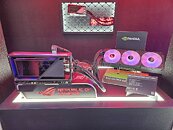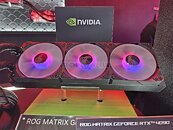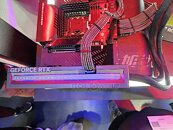- Joined
- Oct 9, 2007
- Messages
- 47,670 (7.43/day)
- Location
- Dublin, Ireland
| System Name | RBMK-1000 |
|---|---|
| Processor | AMD Ryzen 7 5700G |
| Motherboard | Gigabyte B550 AORUS Elite V2 |
| Cooling | DeepCool Gammax L240 V2 |
| Memory | 2x 16GB DDR4-3200 |
| Video Card(s) | Galax RTX 4070 Ti EX |
| Storage | Samsung 990 1TB |
| Display(s) | BenQ 1440p 60 Hz 27-inch |
| Case | Corsair Carbide 100R |
| Audio Device(s) | ASUS SupremeFX S1220A |
| Power Supply | Cooler Master MWE Gold 650W |
| Mouse | ASUS ROG Strix Impact |
| Keyboard | Gamdias Hermes E2 |
| Software | Windows 11 Pro |
ASUS at the 2023 Computex launched the ROG MATRIX GeForce RTX 4090, its absolute top-end custom-design graphics card, designed to be the fastest money can buy. The card features the industry's highest factory-overclock for an RTX 4090, and has its power limits set squarely at 600 W, maxing out the single 16-pin 12VHPWR connector. The card also features the strongest VRM solution ever by ASUS for a graphics card, to hold this PL. The star attraction with this card is that it is marketed as the first graphics card that incorporates liquid metal technology.
What it essentially means, is that the cooling solution uses liquid-metal thermal interface material (TIM) for the GPU. The enthusiasts among you know how difficult it is to apply and maintain liquid metal, and ASUS is among the first companies to do this on an industrial scale, using a fully automated process. The company originally designed this mechanized liquid-metal TIM application technique for its high-end notebooks, but figured it could use it even for graphics cards. Liquid-metal TIMs offer the highest possible thermal conductivity as the TIM is pure metal. It's also electrically conductive, which is why application and maintenance is extremely difficult. ASUS innovated a cold-plate design specifically for this task, so the graphics card could survive international shipping from its factories. A third innovation by ASUS has been to develop a special multi-layer resin that protects the SMD components on the PCB against being shorted by the liquid-metal. ASUS is so confident in its liquid-metal technology, that the company is backing this graphics card with a comprehensive 5-year warranty.




Once the heat is transferred to the cooling solution, where it is dissipated via a copper water-block, it's picked up by a high-pressure coolant, and circulated through a 360 mm x 120 mm radiator, ventilated by three ROG MF-12S ARGB high static-pressure fans with discreet wiring (through contact-point daisy-chaining). Each of the fans is driven by a fan-controller on the card's PCB. Due to its elaborate liquid cooling solution, the card is still 3.5 slots thick, and you need a case that can accommodate graphics cards at least 35 cm in length, as the coolant tubes of this card stick out from the tail end, and need some room to bend.
ASUS has given the PCB of this graphics card an array of temperature sensors that are individually exposed to software. There's also an elaborate mechanism in the card's VRM that lets it detect anomalies in the input power from the 12VHPWR connector on a per-pin basis (that's each of the six +12 V pins). Lastly, the card features dual-BIOS, with the P-BIOS featuring the bonkers 600 W power limit and the yet-undisclosed factory-overclock, and the Q-BIOS running it at a more tame 450 W power limit, with lower clock-speeds, and a relaxed fan-speed profile.
View at TechPowerUp Main Site
What it essentially means, is that the cooling solution uses liquid-metal thermal interface material (TIM) for the GPU. The enthusiasts among you know how difficult it is to apply and maintain liquid metal, and ASUS is among the first companies to do this on an industrial scale, using a fully automated process. The company originally designed this mechanized liquid-metal TIM application technique for its high-end notebooks, but figured it could use it even for graphics cards. Liquid-metal TIMs offer the highest possible thermal conductivity as the TIM is pure metal. It's also electrically conductive, which is why application and maintenance is extremely difficult. ASUS innovated a cold-plate design specifically for this task, so the graphics card could survive international shipping from its factories. A third innovation by ASUS has been to develop a special multi-layer resin that protects the SMD components on the PCB against being shorted by the liquid-metal. ASUS is so confident in its liquid-metal technology, that the company is backing this graphics card with a comprehensive 5-year warranty.




Once the heat is transferred to the cooling solution, where it is dissipated via a copper water-block, it's picked up by a high-pressure coolant, and circulated through a 360 mm x 120 mm radiator, ventilated by three ROG MF-12S ARGB high static-pressure fans with discreet wiring (through contact-point daisy-chaining). Each of the fans is driven by a fan-controller on the card's PCB. Due to its elaborate liquid cooling solution, the card is still 3.5 slots thick, and you need a case that can accommodate graphics cards at least 35 cm in length, as the coolant tubes of this card stick out from the tail end, and need some room to bend.
ASUS has given the PCB of this graphics card an array of temperature sensors that are individually exposed to software. There's also an elaborate mechanism in the card's VRM that lets it detect anomalies in the input power from the 12VHPWR connector on a per-pin basis (that's each of the six +12 V pins). Lastly, the card features dual-BIOS, with the P-BIOS featuring the bonkers 600 W power limit and the yet-undisclosed factory-overclock, and the Q-BIOS running it at a more tame 450 W power limit, with lower clock-speeds, and a relaxed fan-speed profile.
View at TechPowerUp Main Site



